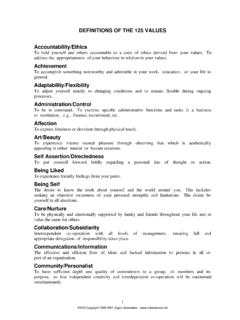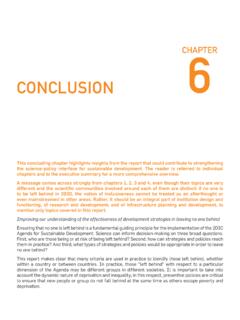Transcription of Part IV: Benefit-Cost Analysis
1 part IV: Benefit-Cost Analysis Outcomes Quantified in Dollars: The Fourth of a Five- part Series Disclaimer: The findings and conclusions in this presentation are those of the author and do not necessarily represent the official position of the Centers for Disease Control and Prevention. This module focuses on Benefit-Cost Analysis , a type of economic evaluation that compares the costs of a program, policy, or intervention to its outcomes, which are converted into dollars. Public Health Model for Prevention 2. Economic evaluations are best conducted once a program, policy, or intervention has proven effective but prior to widespread implementation and dissemination.
2 In this way, economic evaluations are typically conducted retrospectively. However, an economic evaluation is often conducted prospectively, alongside community or clinical trials. Either way, economic evaluations conducted before implementation are the best way to ensure efficient allocation of scarce public health resources. Benefit-Cost Analysis (BCA). Compares costs and benefits of an intervention. Standardizes all costs and benefits in monetary terms. Lists all costs and benefits over time: Can have different time lines for costs and benefits . Can include non-health benefits . Used primarily in regulatory policy analyses.
3 Clean Water Act, Clean Air Act. Increasingly applied to public health. 3. Benefit-Cost Analysis is a type of economic evaluation method where the costs of the program or intervention are compared to the benefits of the intervention, and both costs and benefits use the same units: dollars. Benefit-Cost Analysis allows you to consider all costs and benefits over time, even those beyond the length of the intervention. As is often the case with preventive interventions, the costs of the intervention occur in the immediate future and benefits occur in the distant future. With Benefit-Cost Analysis , costs and benefits , regardless of when they occur, are included in the Analysis .
4 In addition, because all program costs and outcomes are converted into dollars, you can also consider including non-health outcomes associated with an intervention. If you can assign a dollar value to an outcome, you can include it in Benefit-Cost Analysis . For example, a program designed to increase physical activity among seniors living in an adult residential facility may have the added benefit of improving social or psychological relationships. Benefit-Cost Analysis is typically used at the executive level of government when considering regulatory proposals that would be costly to implement but that would have potentially large economic benefits to society.
5 Examples of these regulatory actions are the Clean Air Act and the Clean Water Act. Application of Benefit-Cost Analysis to public health interventions is a more recent phenomenon. BCA Summary Measures Benefit-Cost ratio (B/C). Very popular with stakeholders. For every dollar spent on X, you will save Y dollars.. Implement if B/C ratio > 1. Often misleading. Easy to manipulate costs to get higher ratios. Net benefit (B C). Subtract costs from benefits . Implement if net benefit > 0. Less easily manipulated. 4. There are two common summary measures used in a Benefit-Cost Analysis . The first is a Benefit-Cost ratio.
6 To find this ratio, divide the program's net benefits by its net costs. The result is a summary measure that states, for every dollar spent on program X, Y dollars are saved.. This type of summary measure is popular with policy makers because it's easy to understand. If the Benefit-Cost ratio is greater than 1 dollar, it implies that the program or intervention produces more benefit than it costs. However, the Benefit-Cost ratio is somewhat misleading. If you have a negative ratio, in which the program doesn't save more than it costs, you can't easily determine whether the negative ratio comes from a negative numerator or a negative denominator.
7 A. negative numerator would mean that benefits are listed as negative costs. A negative denominator means costs are listed as negative benefits .. In other words, it's easy to manipulate how costs and benefits are described to get the ratio you want. In this same way, the ratio can be manipulated to show a bigger return on investment than really exists, again by labeling costs as negative benefits or labeling benefits as negative costs. Perhaps a better summary measure for Benefit-Cost Analysis is net benefits , derived by subtracting net costs from net benefits . In this way, programs show a positive return on investment if net benefits are greater than zero.
8 This summary measure is less easily manipulated in terms of how costs and benefits are labeled and thus is the preferred summary measure in Benefit-Cost Analysis . When Is BCA Used? In deciding whether to implement a program. If NB > 0, implement. When choosing among competing options. Implement program with highest NB. For setting priorities when budgets are limited. 5. Benefit-Cost Analysis is used to decide whether to implement one specific intervention or program, which can be determined if net benefits are greater than zero. It can also be used when choosing between competing options. In this case, you would choose the intervention with the highest return on investment or highest net benefit.
9 Finally, Benefit-Cost Analysis is useful when deciding between a whole set of possible interventions with a limited budget. In this case, the net benefits are determined for all the programs, which are ranked in order of decreasing net benefits , and the budget is spent according to the program ranking until the money is gone. Because all costs and outcomes are converted into dollars, the objective ranking of programs by net benefits makes it easy for policy makers to spend a limited budget based on the highest return on investment for society. Assessing Dollar Value of benefits benefits can be direct, indirect, or intangible.
10 Direct benefits : Medical expenditures saved for other purposes. Indirect benefits : Potential increased earnings or productivity gains. Intangible benefits : Psychological benefits of health, satisfaction with life. 6. Assessing program costs in a Benefit-Cost Analysis follows the same methods discussed in the last module. Assessing program benefits in a Benefit-Cost Analysis is a little more challenging than assessing program costs. benefits of an intervention or program can be considered direct, indirect, or intangible. Direct benefits are those medical expenses saved because of prevention or treatment of the disease or illness.












